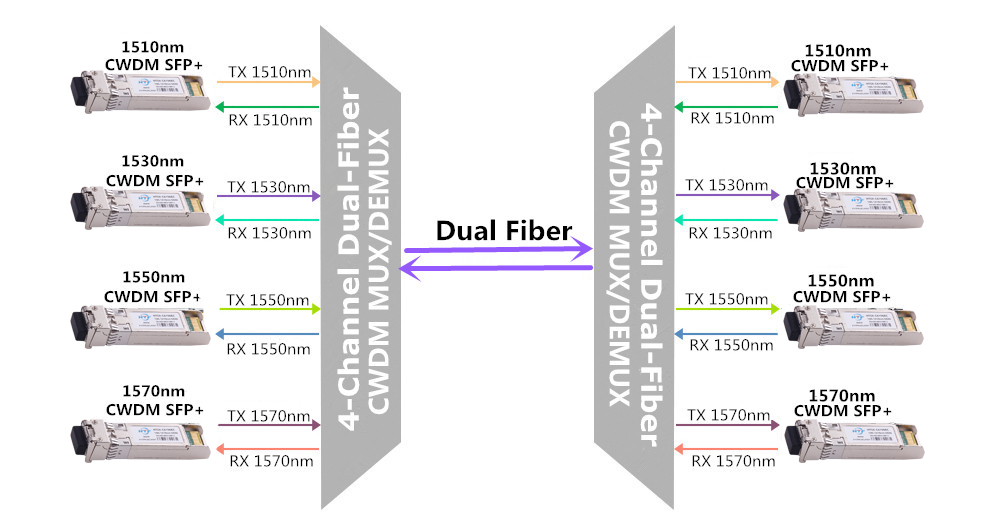What would you do if your network capacity can not meet your requirement? Will you put more fibers or update your system? In fact, these two methods are not very recommendable. Why? As your fiber cabling infrastructure is limited for adding fibers and high cost is required for upgrading system, these two methods are unworkable or too expensive. Under this condition, using a pair of CWDM Mux Demux to build a CWDM system with higher capacity is highly recommended. The CWDM Mux Demux is regarded as a key component for a CWDM system, as shown below. It can be simply divided into two types, dual-fiber and single-fiber CWDM Mux Demux. To meet the higher capacity need of your system, this post will mainly introduce the basic knowledge of the dual-fiber and single-fiber CWDM Mux Demux and guide you find a suitable fiber optic Mux Demux for building your CWDM system.

When the connection above works, the left 4 channel dual-fiber CWDM Mux Demux uses 1510 nm, 1530 nm, 1550 nm and 1570 nm for transmitting 4 kinds of signals through the first fiber, while the right 4 channel dual-fiber CWDM Mux Demux features 1510 nm, 1530 nm, 1550 nm and 1570 nm for receiving the signals. On the other hand, the transmission from the right to left use the same wavelengths to carry another 4 signals through the second fiber, finally achieving the bidirectional signal transmission.

The working principle of single-fiber CWDM Mux Demux is more complicated, compared to the dual-fiber one. As shown in the figure above, the transmission from the left to right uses 1470 nm, 1510 nm, 1550 nm and 1590 nm to multiplex the signals, transmit them through the single fiber, and using the same four wavelengths to demultiplex the signals, while the opposite transmission carries signals with 1490 nm, 1530 nm, 1570 nm and 1610 nm over the same fiber. As for the wavelength of the transceiver, it should use the same wavelength as TX of the port on the CWDM Mux Demux. For example, when the port of a single-fiber CWDM Mux Demux has 1470 nm for TX and 1490 nm for RX, then a 1470nm CWDM transceiver should be inserted.
We always consider whether an item is worth buying according to its performance and cost. In view of the performance, the single-fiber CWDM Mux Demux can carry signals through only one fiber supporting fast speed transmission and saving the fiber resource, while the dual-fiber one requires two fibers for transmission with higher reliability. Besides, using single-fiber CWDM Mux Demux can be easier to install. In view of the cost, the single-fiber CWDM Mux Demux is much more expensive than the dual-fiber. And the simplex fiber cable also costs higher than duplex fiber cable. Thereby, the whole cost for building the single-fiber CWDM system must be much higher. Like the two sides of the same coin, both the dual-fiber and single-fiber CWDM Mux Demux have their own advantages and disadvantages. Which one you should choose just depends on your system needs and your budget for building the CWDM system.


